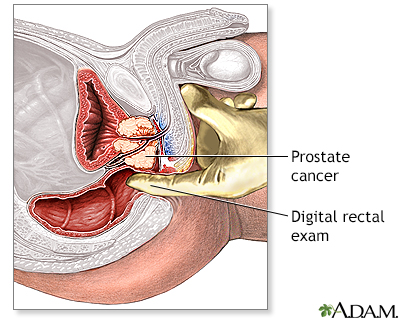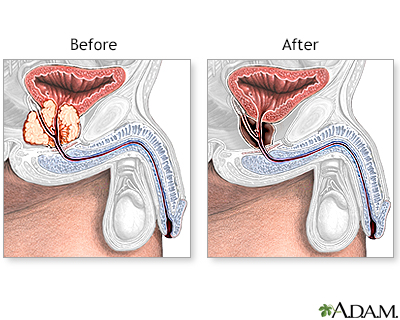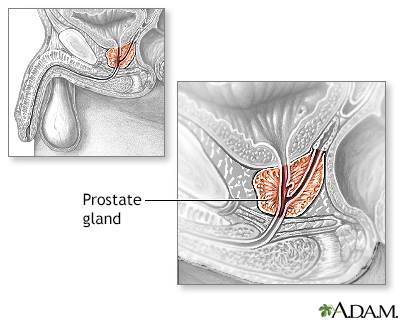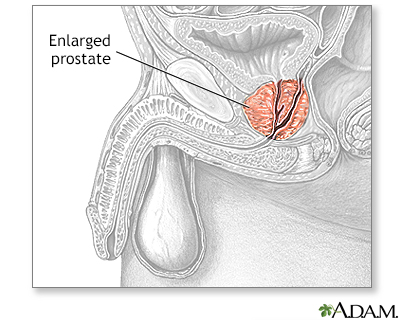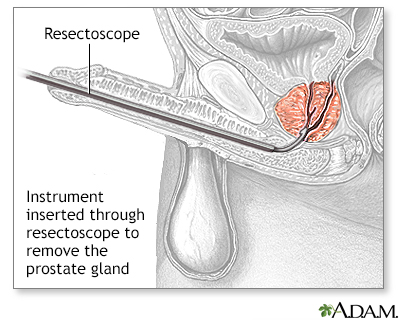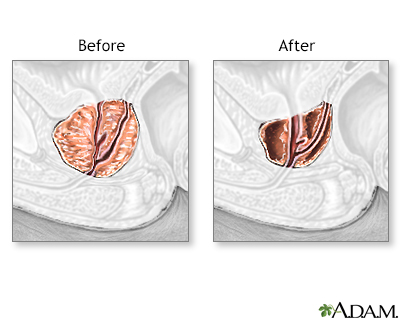Transurethral resection of the prostate
TURP; Prostate resection - transurethralTransurethral resection of the prostate (TURP) is a surgery to remove the inside part of the prostate gland. It is done in order to treat symptoms of an enlarged prostate.
Enlarged prostate
The prostate is a gland that produces some of the fluid that carries sperm during ejaculation. The prostate gland surrounds the urethra, the tube th...

Description
The surgery takes about 1 to 2 hours.
You will be given medicine before surgery so you don't feel pain. You may get general anesthesia in which you are asleep and pain-free or spinal anesthesia in which you are awake, but numb from the waist and below.
Your surgeon will insert a scope through the tube that carries urine from your bladder out of the penis. This instrument is called the resectoscope. A special cutting tool is placed through the scope. It is used to remove the inside part of your prostate gland using electricity.
Why the Procedure Is Performed
Your health care provider may recommend this surgery if you have benign prostatic hyperplasia (BPH). The prostate gland often grows larger as men get older. The larger prostate may cause problems with urinating. Removing part of the prostate gland can often make these symptoms better.
BPH
The prostate is a gland that produces some of the fluid that carries sperm during ejaculation. The prostate gland surrounds the urethra, the tube th...

TURP may be recommended if you have:
- Difficulty emptying your bladder
- Frequent urinary tract infections
Urinary tract infections
A urinary tract infection, or UTI, is an infection of the urinary tract. The infection can occur at different points in the urinary tract, including...
 ImageRead Article Now Book Mark Article
ImageRead Article Now Book Mark Article - Bleeding from the prostate
-
Bladder stones with prostate enlargement
Bladder stones
Bladder stones are hard buildups of minerals. These form in the urinary bladder.
 ImageRead Article Now Book Mark Article
ImageRead Article Now Book Mark Article - Extremely slow urination
- Damage to the kidneys due to an inability to urinate
- Getting up often at night to urinate
- Bladder control issues due to a large prostate
Before you have surgery, your provider will suggest you make changes in how you eat or drink. You may also be asked to try taking medicine. Part of your prostate may need to be removed if these steps do not help. TURP is one of the most common types of prostate surgery. Other procedures are also available.
Your provider will consider the following when deciding on the type of surgery:
- Size of your prostate gland
- Your health
- What type of surgery you may want
- The severity of your symptoms
Risks
Risks for any surgery are:
-
Blood clots in the legs that may travel to the lungs
Blood clots
Blood clots are clumps that occur when blood hardens from a liquid to a solid. A blood clot that forms inside one of your veins or arteries is calle...
 ImageRead Article Now Book Mark Article
ImageRead Article Now Book Mark Article -
Breathing problems
Breathing problems
Breathing difficulty may involve:Difficult breathing Uncomfortable breathingFeeling like you are not getting enough air
 ImageRead Article Now Book Mark Article
ImageRead Article Now Book Mark Article - Infection, including in the surgical wound, lungs (pneumonia), bladder or kidney
Pneumonia
Pneumonia is inflamed or swollen lung tissue due to infection with a germ. This article covers community-acquired pneumonia (CAP). This type of pneu...
 ImageRead Article Now Book Mark Article
ImageRead Article Now Book Mark Article -
Blood loss
Blood loss
Bleeding is the loss of blood. Bleeding may be:Inside the body (internal)Outside the body (external)Bleeding may occur:Inside the body when blood le...
 ImageRead Article Now Book Mark Article
ImageRead Article Now Book Mark Article -
Heart attack or stroke during surgery
Heart attack
Most heart attacks are caused by a blood clot that blocks one of the coronary arteries. The coronary arteries bring blood and oxygen to the heart. ...
 ImageRead Article Now Book Mark Article
ImageRead Article Now Book Mark ArticleStroke
A stroke occurs when blood flow to a part of the brain stops. A stroke is sometimes called a "brain attack. " If blood flow is cut off for longer th...
 ImageRead Article Now Book Mark Article
ImageRead Article Now Book Mark Article - Reactions to medicines
Additional risks are:
- Problems with urine control
- Loss of sperm fertility
- Erection problems
- Passing the semen into the bladder instead of out through the urethra (retrograde ejaculation)
Retrograde ejaculation
Retrograde ejaculation occurs when semen goes backward into the bladder. Normally, it moves forward and out of the penis through the urethra during ...
 ImageRead Article Now Book Mark Article
ImageRead Article Now Book Mark Article -
Urethral stricture (tightening of the urinary outlet from scar tissue)
Urethral stricture
Urethral stricture is an abnormal narrowing of the urethra. The urethra is the tube that carries urine out of the body from the bladder.
 ImageRead Article Now Book Mark Article
ImageRead Article Now Book Mark Article - Transurethral resection (TUR) syndrome (water buildup during surgery)
- Damage to internal organs and structures
Before the Procedure
You will have many visits with your provider and tests before your surgery. Your visit will include:
- Complete physical exam
- Treating and controlling diabetes, high blood pressure, heart or lung problems, and other conditions
Diabetes
Diabetes is a long-term (chronic) disease in which the body cannot regulate the amount of sugar in the blood.
 ImageRead Article Now Book Mark Article
ImageRead Article Now Book Mark ArticleHigh blood pressure
Blood pressure is a measurement of the force exerted against the walls of your arteries as your heart pumps blood to your body. Hypertension is the ...
 ImageRead Article Now Book Mark Article
ImageRead Article Now Book Mark Article
If you are a smoker, you should stop several weeks before the surgery. Your provider can give you tips on how to do this.
Tips on how to do this
There are many ways to quit smoking. There are also resources to help you. Family members, friends, and co-workers may be supportive. But to be su...

Always tell your provider what medicines, vitamins, and other supplements you are taking, even ones you bought without a prescription.
During the weeks before your surgery:
- You may be asked to stop taking medicines that can thin your blood, such as aspirin, ibuprofen (Advil, Motrin), naproxen (Aleve, Naprosyn), vitamin E, clopidogrel (Plavix), warfarin (Coumadin), apixaban (Eliquis), and others.
- Ask your surgeon which medicines you should still take on the day of your surgery.
On the day of your surgery:
- Do not eat or drink anything after midnight the night before your surgery.
- Take the medicines you have been told to take with a small sip of water.
- You will be told when to arrive at the hospital.
After the Procedure
You will most often stay in the hospital for 1 to 3 days. In some cases, you may be allowed to go home the same day.
After surgery, you will have a small tube, called a Foley catheter, in your bladder to remove urine. Your bladder may be flushed with fluids (irrigated) to keep it clear of clots. The urine will look bloody at first. In most cases, the blood goes away within a few days. Blood can also seep around the catheter. A special solution may be used to flush out the catheter and keep it from getting clogged with blood. The catheter will be removed within 1 to 3 days for most people.
Foley catheter
A urinary catheter is a tube placed in the body to drain and collect urine from the bladder.

You will be able to go back to eating a normal diet right away.
Your health care team will:
- Help you change positions in bed.
- Teach you exercises to keep blood flowing.
- Teach you how to perform coughing and deep breathing techniques. You should do these every 3 to 4 hours.
- Tell you how to care for yourself after your procedure.
Care for yourself
You had transurethral resection of the prostate (TURP) surgery to treat an enlarged prostate. This article tells you how to take care of yourself at...
 ImageRead Article Now Book Mark Article
ImageRead Article Now Book Mark Article
You may need to wear tight stockings and use a breathing device to keep your lungs clear.
You may be given medicine to relieve bladder spasms.
Outlook (Prognosis)
TURP relieves symptoms of an enlarged prostate most of the time. You may have burning with urination, blood in your urine, frequent urination, and need to urgently urinate. This usually resolves after a little bit of time.
References
Han M, Partin AW. Simple prostatectomy: open and robotic-assisted laparoscopic approaches. In: Partin AW, Domochowski RR, Kavoussi LR, Peters CA, eds. Campbell-Walsh-Wein Urology. 12th ed. Philadelphia, PA: Elsevier; 2021:chap 147.
Milam DF. Transurethral resection and transurethral incision of the prostate. In: Smith JA Jr, Howards SS, Preminger GM, Dmochowski RR, eds. Hinman's Atlas of Urologic Surgery. 4th ed. Philadelphia, PA: Elsevier; 2019:chap 67.
Parsons JK, Dahm P, Kohler TS, Lerner LB, Wilt TJ. Surgical management of lower urinary tract symptoms attributed to benign prostatic hyperplasia: AUA Guideline Amendment 2020. J Urol. 2020;204(3):799-804. PMID: 32698710 pubmed.ncbi.nlm.nih.gov/32698710/.
Roehrborn CG, Strand DW. Benign prostatic hyperplasia: etiology, pathophysiology, epidemiology, and natural history. In: Partin AW, Domochowski RR, Kavoussi LR, Peters CA, eds. Campbell-Walsh-Wein Urology. 12th ed. Philadelphia, PA: Elsevier; 2021:chap 144.
-
Male reproductive anatomy - illustration
The male reproductive structures include the penis, the scrotum, the testicles (testes), the epididymis, the seminal vesicles, and the prostate.
Male reproductive anatomy
illustration
-
Prostate gland - illustration
The prostate gland is a fibrous organ that surrounds the urinary urethra at the base of the bladder.
Prostate gland
illustration
-
Prostatectomy - series - Normal anatomy
Presentation
-
Transurethral Resection of the Prostate (TURP) - Series
Presentation
-
Male reproductive anatomy - illustration
The male reproductive structures include the penis, the scrotum, the testicles (testes), the epididymis, the seminal vesicles, and the prostate.
Male reproductive anatomy
illustration
-
Prostate gland - illustration
The prostate gland is a fibrous organ that surrounds the urinary urethra at the base of the bladder.
Prostate gland
illustration
-
Prostatectomy - series - Normal anatomy
Presentation
-
Transurethral Resection of the Prostate (TURP) - Series
Presentation
Review Date: 7/1/2023
Reviewed By: Kelly L. Stratton, MD, FACS, Associate Professor, Department of Urology, University of Oklahoma Health Sciences Center, Oklahoma City, OK. Also reviewed by David C. Dugdale, MD, Medical Director, Brenda Conaway, Editorial Director, and the A.D.A.M. Editorial team.





